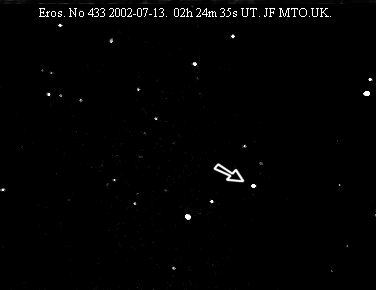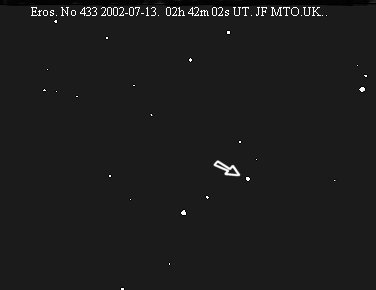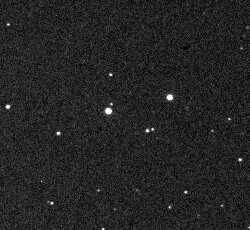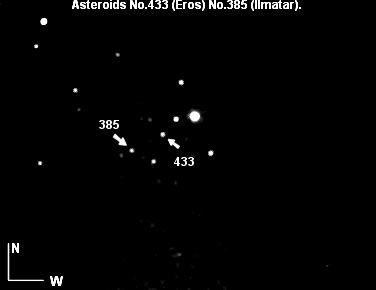(433) Eros
(433)
Eros was the first Mars-crossing asteroid to be discovered and the first known
asteroid that could make a close approach to the Earth. The discovery was made
by G.Witt at
When
it makes a close approach to the Earth, as in 1931 and 1975, when its distance
was 23 million kilometres, it can reach magnitude 8.3 and is the 6th brightest
asteroid in terms of the maximum brightness that it can reach. Eros is very
elongated and resembles a somewhat deformed potato.
The
asteroid was studied by the NEAR-Shoemaker probe in 2001 and a huge amount of high-quality
data was obtained, including extreme close-up images of the surface obtained
during the remarkable soft landing of the probe on the surface on
Eros is classified as an Amor asteroid - one that has its perihelion between the orbit of the Earth and Mars. The period is 1.76 years and the perihelion distance 1.133AU.
The light curve
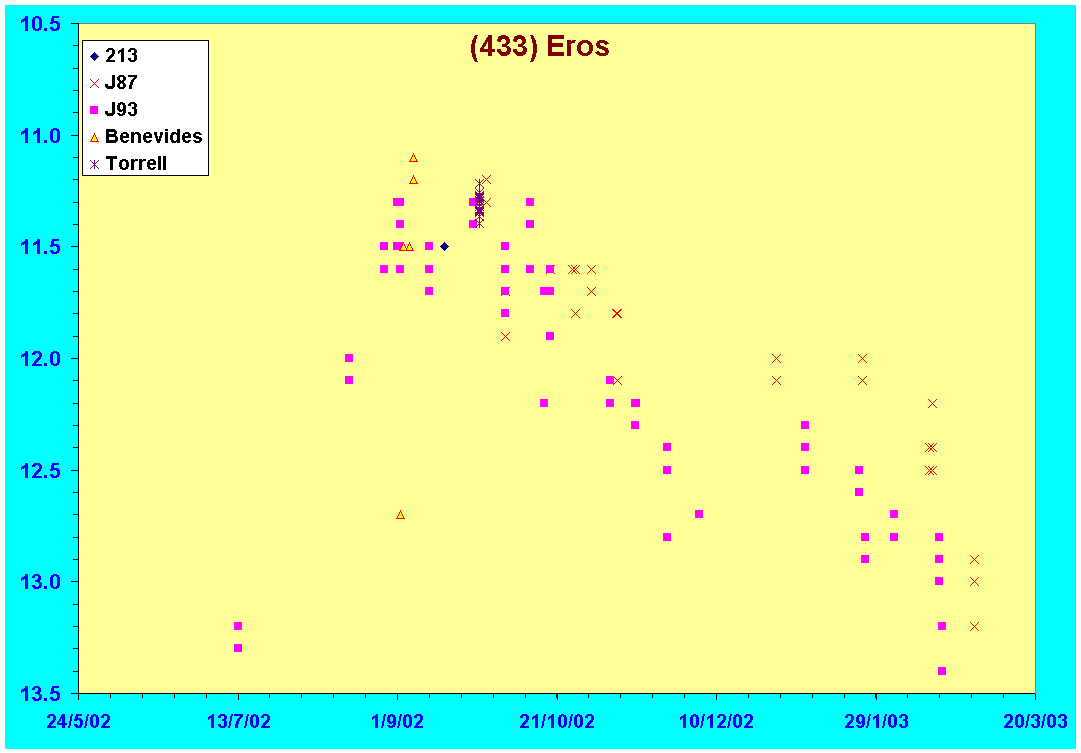 In 2002 Eros is making a moderately close to
the Earth. Such approaches receive far less attention than the very close
approaches like that of 1975 but even when the circumstances are not optimum,
Eros can become quite bright. As we can see from the data, its magnitude has
reached 11 during summer 2002.
In 2002 Eros is making a moderately close to
the Earth. Such approaches receive far less attention than the very close
approaches like that of 1975 but even when the circumstances are not optimum,
Eros can become quite bright. As we can see from the data, its magnitude has
reached 11 during summer 2002.
Given that Eros is so
strongly elongated, its light curve shows a very high amplitude of variability.
This variability was first detected in 1900 by the German, von Oppolzer. The
rotation period is 5.27 hours and at a very close approach the asteroid can
even be seen to be spinning visually as its aspect (and apparent shape) change
with the rotation phase. The first visual observations of Eros's shape were
made by Finsen and van den Bos at Johannesburg Observatory during the 1931
close approach.
Part of the dispersion in
the data is thus due to genuine variability of Eros. A few hours monitoring of
the asteroid is usually sufficient to show the rotational light curve very
clearly. However, the amplitude of the rotational light curve depends on the
presentation of the asteroid and will vary from 0.04 magnitudes (end-on
presentation) to 1.49 magnitudes (edge-on presentation).
As we see, (433) Eros
reached maximum in early September at approximately magnitude 11.5. Rafael
Benevides followed Eros visually for two hours on 2002 September 5th
without detecting variation. A similar conclusion comes from John Fletcher's
CCD data, which shows very little dispersion. This suggests that Eros is close
to minimum light curve amplitude at this apparition. Sebastià Torrell points
out that the pole of rotation is currently very close to the current sub-Earth
point thus the rotation curve is minimised.
Observations from:
- Ramón Naves & Montse Campàs - MPC 213
- Juan Lacruz - MPC J87
- John Fletcher - MPC J93
- Sebastià Torrell
Visual estimates from:
- Rafael Benavides
Image:
Image of (433) Eros taken with a 25.4-cm Schmidt Cassegrain at prime
focus. Starlight Express MX916usb.
John Fletcher F.R.A.S.
jfmto@blueyonder.co.uk http://www.jfmto.pwp.blueyonder.co.uk
Mount Tuffley Observatory. Code J93.
Latitude: North 51 degrees 48minutes 51.3 seconds.
Longitude: West 02 degrees 15minutes 26.6
seconds.
Image:
Image of (433) Eros taken with a 25.4-cm Schmidt Cassegrain at prime
focus. Starlight Express MX916usb.
++++++++++++++++++++++++++++++
John Fletcher F.R.A.S.
jfmto@blueyonder.co.uk
Mount Tuffley Observatory. Code J93.
Latitude: North 51 degrees 48minutes 51.3 seconds.
Longitude: West 02 degrees 15minutes 26.6
seconds.
http://www.jfmto.pwp.blueyonder.co.uk
Image:
Animation of (433) Eros.
++++++++++++++++++++++++++++++
Ramón Naves & Montse Campàs
ramonnaves@telefonica.net mcampas@telefonica.net
MPC 213, OBSERVATORIO MONTCABRER CABRILS (SPAIN)
Image:
Image of (433) Eros making a close approach to (385) Ilmatar taken with
a 25.4-cm Schmidt Cassegrain at prime focus. Starlight Express MX916usb.
John Fletcher F.R.A.S.
jfmto@blueyonder.co.uk http://www.jfmto.pwp.blueyonder.co.uk
Mount Tuffley Observatory. Code J93.
Latitude: North 51 degrees
48minutes 51.3 seconds. Longitude: West 02 degrees 15minutes 26.6 seconds.
Última actualización 12/03/2003
Por M.R.Kidger
